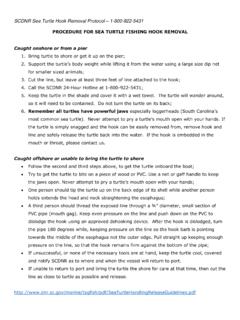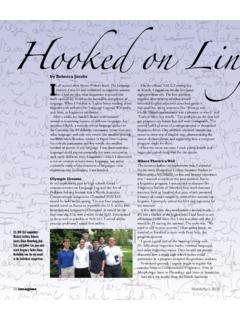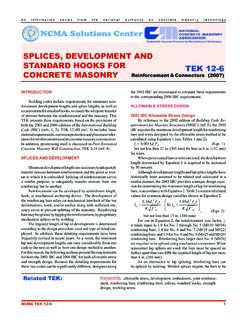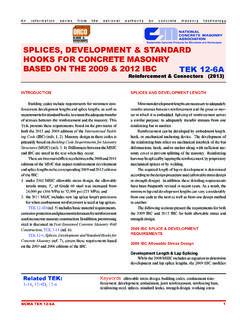Transcription of WORKBOOK - NirandFar.com
1 hooked WORKBOOK | CHAPTER X1 Copyright 2014 Nir Eyal, All rights reserved. SUPPLEMENTALWORKBOOKSPECIAL OFFERTESTIMONIALSBuy hooked now and receive a special book bundle. You ll receive four valuable resources to help you build habits in yourself and your userFirst, buy your copy of hooked by clicking a retailer below, then # & You ll read this. Then you ll hope your competition isn t reading this. It s that good. When it comes to driving engagement and building habits, hooked is an excellent guide into the mind of the user. Nir s work is an essential crib sheet for any startup looking to understand user psychology. Stephen P.
2 AndersonAuthor of Seductive Interaction Design The book, very easy to read and understand the topic. Radek Vacha | 97 reviewers made a similar statement If you read one product book this year, make sure it s this one. Mr Daniel J Groch | 68 reviewers made a similar statement Nir shares some great insight that I applied in my product design. Cyril Labidi | 52 reviewers made a similar statementAndrew ChenTechnology Writer & InvestorDave McClureFounder of 500 startupsHOOKED SUPPLEMENTAL WORKBOOK2 Note from the Author:One of the key lessons I stress in my book, hooked : How to Build Habit-Forming Products, is the importance of simplicity.
3 When a behavior is easier to do, it is more likely people will do it. Hence, if I wanted people to act upon what they read in my book, I needed to find a way to simplify the action I wanted them to take. This supplemental WORKBOOK is designed to guide you through thinking and applying the lesson in hooked to your own business. It is not a replacement for the book of course, but rather a place to reinforce the main ideas and digest what you ve learned. Though not exhaustive, lessons from select chapters are bullet-pointed and come with accompanying exercises to guide you through the steps of designing a habit-forming product or service of your own.
4 By the end this WORKBOOK , you should have a deeper understanding of the Hook Model and a set of hypotheses you can test to make your product or service more engaging. I wish you great success and hope you will use what you learn to build things that move people!Sincerely,Nir SUPPLEMENTAL WORKBOOK4 THE BASICS OF HABITSR emember this: Habits are defined as behaviors done with little or no conscious thought (Figure 1) Hooks are experiences designed to connect the user s problem to a solution frequently enough to form a habit To form a habit, people must do the behavior 1: The Hook ModelNote: Make sure you read the introduction and first chapter of hooked to fully understand these concepts before completing the exercises next.
5 The Hook Model has four phases: trigger, action, variable reward, and SUPPLEMENTAL WORKBOOK 5 EXERCISE 1:1.) Select the product or service you want to make more engaging. We will use this project forall the subsequent exercises. Write down the name of the project here:2.) Why does your business model require users form a habit? 3.) What problem are users solving with your product?4.) How do users currently solve that problem and why does it need a solution? 5.) What is the user behavior you want to turn into a habit? (the intended habitual behavior) hooked SUPPLEMENTAL WORKBOOK66.) How frequently do you expect users to engage with your product?
6 (Note: If the behavior does not occur within a week s time or less, you may have a very difficult time forming a habit.) hooked SUPPLEMENTAL WORKBOOK 7 TRIGGERSR emember this: Triggers cue the user to take action and are the first step in the Hook Model. Triggers come in two types external and internal. External triggers tell the user what to do next by placing information within the user s environment. Internal triggers tell the user what to do next through associations stored in the user s memory. Negative emotions frequently serve as internal triggers. Be sure to understand which user emotions may be tied to internal triggers and know how to leverage external triggers to drive the user to : Make sure you read the second chapter of hooked to fully understand these concepts before completing the exercises next.
7 hooked SUPPLEMENTAL WORKBOOK 8 EXERCISE 2:1.) Who is your product s user? Be clear about the person you intend to help form a habit. Can you name a real person you know that needs your product?2.) What is the user doing right before he or she does the intended habitual behavior youdefined in Exercise 1?3.) Using the 5 Whys technique described in the book, come up with three internal triggers that could cue your user to action. 4.) What internal trigger does your user experience most often? hooked SUPPLEMENTAL WORKBOOK 95.) Using your most frequent internal trigger and the intended habitual behavior you described in Exercise 1, finish the brief narrative belowEvery time the user (internal trigger) , he/she (intended habitual behavior).
8 For example: Every time the Jenny feels bored, she opens the Facebook app on her ) Referring back to question 2, what might be the best places and times to display an external trigger?7.) How can you time your external trigger so that it fires as closely as possible to when your user experiences their internal trigger?8.) Think of at least three conventional ways (e-mails, direct mail, text messages, etc.) and three crazy or currently impossible ways (wearable computers, biometric sensors, carrier pigeons, etc.) to trigger your user with an external trigger the moment he or she experiences the internal SUPPLEMENTAL WORKBOOK 10 ACTIONR emember this: The second step in the Hook Model is the Action.
9 The action is the simplest behavior in anticipation of reward. Dr. B. J. Fogg s Behavior Model says: For any behavior to occur, a trigger must be present at the same time as the user has sufficient ability and motivation to take action. To increase the desired behavior, ensure a clear trigger is present; next, increase ability by making the action easier to do; finally, align with the right motivator. Every behavior is driven by one of three Core Motivators: Seeking pleasure and avoiding pain Seeking hope and avoiding fear Seeking social acceptance while avoiding social rejection. Ability is user and context dependent and is influenced by six factors: time, money, physical effort, brain cycles, social deviance, and non-routineness.
10 Heuristics are cognitive shortcuts we take to make quick decisions. Product designers can utilize many of the hundreds of heuristics to increase the likelihood of their intended habitual : Make sure you read the third chapter of hooked to fully understand these concepts before completing the exercises next. hooked SUPPLEMENTAL WORKBOOK 11 EXERCISE 3:1.) Starting from the time your user feels their internal trigger, count the number of steps it takes to reach the expected outcome. a. How does this process compare with the simplicity of some of the examples described in chapter 3 of hooked ? b. How does this compare with competitors products and services?









